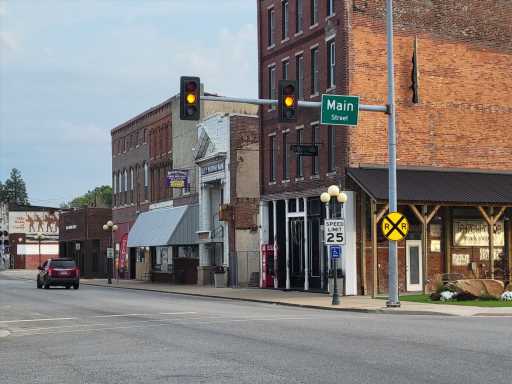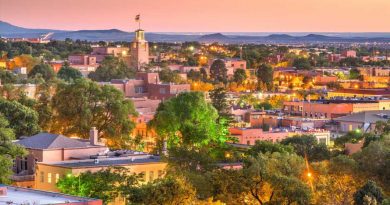Commentary: A small town succeeds because “everyone bought in”
Casey, Ill., claims a lot of big things: the world’s biggest wind chime, chair, mailbox, knitting needle and pencil. But that’s not all it’s got.
I attended a family wedding in Michigan in July and chose to drive from my home in Colorado and stay in sleeping cabins. In my 55 years in America, I’d never been to the Midwest; this was a great opportunity to explore. The campground clerk in Casey recommended an excellent Mexican restaurant downtown.
This is what I noticed on the way: irrigation equipment used to hang a collection of American flags that gleamed in the late light. Lots of freshly painted homes with neatly tended yards. All the storefronts downtown occupied, and even a boutique that sold $30 insulated cups along with glittery party gear. An immaculate outdoor stage, well designed and shaded by city buildings. And a line that waited patiently outside the ice cream shop.
I asked the matron who, along with a host of teenagers, ran the busy ice cream shop, and what made the difference there? Why is her town, in the middle of corn and soybean fields, thriving?
“Everyone bought in,” she said. “Everybody. We all agreed, and everyone on Main Street did their part.”
Sitting next to me, as we happily munched our frozen treats, were tourists from Chicago, 200 miles away. We all agreed that Casey, Ill., a town with one stoplight and some big things, was worth a stop.
In June, I went camping in southern Colorado and New Mexico. It was tough to see that often the small towns there looked like some disaster struck them. In Raton, N.M., and Walsenburg, at least two-thirds of the storefronts are papered over, and many homes seem destined to subside back to the earth, the adobe melting with the spring rains, the roof shingles dissipating, and the paint fading and peeling.
Raton and Walsenburg don’t have big things, but they don’t need them; they both have natural settings of singular beauty. Walsenburg’s backdrop is easily among the most charismatic I’ve ever seen: The Spanish Peaks, with ever-changing details but a silhouette so distinct that their Indigenous name, Huajatolla, means “breasts of the world.”
Like Casey, it’s a town just off the interstate, on the way to a lot of places: the Great Sand Dunes, Durango, Pagosa Springs, Mesa Verde. It’s next to lovely, comfortable Lathrop State Park. And yet, census data shows that its economic numbers are going down, and its population largely consists of retirees. It started out as a coal town, and now its largest employers are hospitality and retail, which seems unfortunate because, on our recent visit, we were able to find one OK restaurant and two stores.
Raton, just on the other side of the New Mexico border, is the gateway to Sugarite, possibly the loveliest state park I’ve ever been to, and a perfect place to lunch, between Raton Pass and the long stretch of highway to Santa Fe. Why aren’t these towns thriving, when a tiny spot in the soybean fields of Illinois is?
It turns out I’m not the only one to notice. Illinois public TV staged an interview with Casey’s mayor and economic development coordinator in 2017. The mayor, Nik Groothuis, a retired educator, professed, “Who would have thought that we would ever have congestion downtown?” Casey isn’t that different from other small towns in America, he thought, but “I’ve learned here that a successful community comes together.”
Casey started as an oil and agriculture town, but its residents started building the Big Things: They put up a couple of billboards on Interstate 70, and actively recruited businesses to occupy their storefronts. Every summer they have a popcorn festival. The tourists show up in droves.
I found all this in a 10-second Google search. I attempted a similar approach for Walsenburg, finding some census data and a city government page with some non-functioning links. I called the mayor and the city administrator and left messages; I’ve received no callbacks yet. I can’t help but wonder: Were I an entrepreneur, where would I be more likely to start a business?
Like many, I used to blame the moribund state of small-town main streets on the interstate highway system, and on big-box stores on the outskirts. No doubt they play a role, but I’m no longer certain that those factors are unstoppable. Because a small town in Illinois has figured out that if you have a plan, and you pursue it with optimism and cooperation, you can win.
Eva Syrovy was one of the 2010 class of Colorado Voices. An immigrant from Czechia, she is the mother of two sons, a retired teacher, and owner and resident of a 120-year-old house on Colorado Springs’ west side.
Sign up for Sound Off to get a weekly roundup of our columns, editorials and more.
To send a letter to the editor about this article, submit online or check out our guidelines for how to submit by email or mail.
Source: Read Full Article





